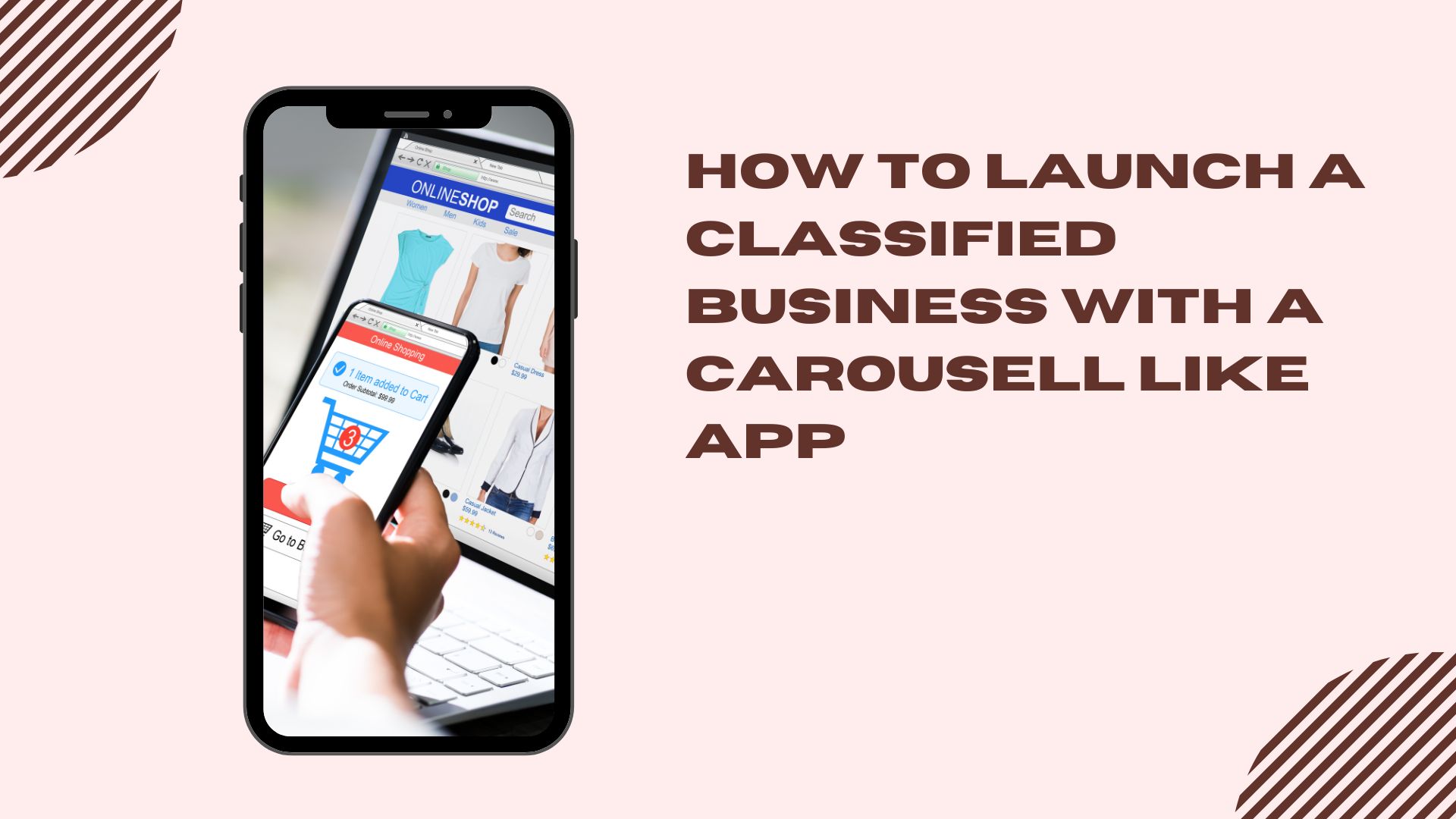
A classified business focuses on listing and connecting buyers with sellers online through categories like jobs, real estate, vehicles, and other goods and services. Carousell is a popular mobile app for classified listings that has found worldwide success with its simple yet effective listing and browsing experience. With the availability of white-label solutions and Carousell clones, businesses can now launch their own classified listing platforms to cater to local markets.
This blog provides a step-by-step guide for starting a classified business using a Carousell like app. You will learn how to analyze the market opportunity, choose a business model, develop the app, drive listings and user engagement, implement payments and transactions, carry out marketing, and scale the business through continuous improvements. By following these steps, you can launch and grow a profitable classifieds listing platform tailored to your target audience’s needs.
Analyze the market opportunity
The first step is to research your target market and understand demand for classified listings in your local area or niche. Look at popular online and offline classified platforms to gauge popular categories and how they are addressing user needs. Identify white spaces and opportunities where you can differentiate. Some categories to consider include jobs, real estate, vehicles, goods & services, tutoring/courses, professional services, and community groups.
You should also analyze competitors providing similar services. Look at their pricing models, features, marketing strategies, and how they are monetizing. This will help you decide where you can offer unique value propositions to attract users away from competitors. Factors like customization options, local focus, specialized categories, verified sellers, and dedicated customer support can help differentiate your platform.
Conducting informant interviews with local businesses and users can also provide valuable qualitative insights. Ask them about current pain points, wishlist of features for a local classifieds platform, and factors that would make them prefer your upcoming app over others. These findings will help shape your minimum viable product. Dive Deeper: https://zipprr.com/carousell-clone/
Choose a business model
With market research complete, you need to decide the business model components like revenue streams, pricing, and funding requirements. Here are some factors to consider:
Listing pricing – Will listings be free or will you charge a fee? Free generally stimulates more listings but paid reduces spam. Consider a hybrid model with limited free listings.
Commissions – Take a cut (5-20%) from completed sale/service transactions on the app to generate recurring income.
Subscriptions – Offer paid tiers with premium features to make recurring revenue from businesses and high volume users.
Ads – Sell ad space within the app to local businesses looking to promote themselves.
Private channels – Premium communities/groups with a monthly subscription.
Funding required – Develop a budget estimating development cost and initial 6-12 months operating expenses before monetization kicks in. Raise funds or partner with investors accordingly.
With monetization and funding models mapped out, you are ready to develop the minimum viable product for launch and user testing.
Website or mobile app
Today, mobile apps are generally more attractive than responsive websites for a local classifieds platform due to its native functionality and seamless experience on phones. Users prefer browsing listings and connecting with sellers using their mobile devices.
Some key reasons to develop a mobile app over a website:
-
Native features like camera, notifications improve UX
-
App Store positioning and search/browse discoverability
-
Mobile engagement – users visit apps 18x more than mobile sites
-
Push notifications for instant updates
-
Offline access for locations with unreliable internet
-
Ability to monetize via in-app purchases
However, a website can still be used to handle backend workflows for sellers and site management along with the app. You should integrate both to provide full functionality wherever users need it.
Develop the classifieds app
With the platform choice decided, it’s time to develop the actual classifieds app development. You have two development models to choose from:
Hire a dedicated developer – For advanced customizations, a dedicated development team will be required. This involves higher costs but more control over roadmap and ownership of IP. Budget $15k – $50k typically for an MVP.
No-code platform – Use no-code solutions like AppMaster, Bubble, or Formatic to build the app without writing code. Faster and cheaper (~$5k) but has limited customizations versus custom code. Good for initial testing.
Once the platform is chosen, work with your developer or no-code partner to flesh out the following core functionality and experience:
-
Browsing listings in categories, location, search
-
Listing submission forms with images/videos
-
User profiles, reviews, and seller/buyer dashboards
-
Notifications, messaging, and booking/inquiry forms
-
Payments setup for transactions
-
Administrator panel for moderating listings
-
App store listing page and initial marketing assets
Spend time on user experience design principles to ensure seamless and intuitive navigation across all app sections. Get early feedback on wireframes and have your developer iterate based on that. The goal is to deliver an MVP for your market testing phase.
Onboard listings
Now that you have a working minimum viable app, it’s time to promote it to local businesses and users to submit their initial listings. Some promotion tactics can include:
-
Email campaigns to local SME community groups
-
Social media ads targeted to your city
-
Local press release about new classifieds platform launch
-
Offline events partnership with chambers, incubators
-
Flyers, brochures at co-working spaces, colleges
Train customer support executives to onboard listings over calls and answer queries. Have a dedicated listing approval workflow so users get prompt responses. Provide template listing forms and images to guide quality submissions.
Offer incentives for high volume users like pro seller badges, advertising credits to jumpstart adoption. Onboarding the first 100+ listings is crucial to giving users a reason to open the app and continue using it. Constant communication and support will keep submitters engaged during this initial phase.
Drive discovery and engagement
With listings live, your priority shifts to driving app usage and transactions. Work on the following engagement strategies:
-
Recommendations based on past browsing
-
Push notifications for new relevant listings
-
Contextual search filters for dynamic results
-
Location-based listings on map view
-
User profiles for social connections
-
Reviews and ratings to build trust
-
Online to offline incentives like deals
-
Contests and listings featured on homepage
-
Customer support response within minutes
-
Help Center FAQs for common queries
Social features like following sellers, saving listings, and sharing give users interactive content to browse even if not transacting immediately. Nurture relationships through personalized communications and rewards to foster loyalty on your platform.
Payment and transaction management
Accepting payments online is crucial for your revenue streams like commissions, ad spend, and subscriptions. Integrate with popular payment gateways like PayPal, Stripe or Razorpay based on your country and support localized payment methods.
Implement order management functionality for successful transactions:
-
Bookings, inquiries and conversation threads
-
Order and invoice tracking
-
Payment collection and settlement
-
Buyer and seller dispute resolution
-
Commission/pay-outs for completed orders
-
Transaction reports for data analytics
Secure SSL certification to give users confidence while paying within the app. Have seller payout details verified to ensure seamless disbursals. Prompt issue resolution will differentiate your customer support in this important phase.
Marketing and promotion
Even with a quality product, your classifieds platform needs marketing efforts to gain awareness and users:
-
Search engine optimization of app listing and website
-
Google and Facebook ads targeted to geo-locations
-
Promoted social media posts and influencer collaborations
-
SMS and email campaigns with call-to-action buttons
-
Outdoor branding like auto rickshaw ads (emerging markets)
-
On-ground events like college fests with booth presence
-
PR articles highlighting launched features
-
Local business partnerships for cross-promotions
-
Contests on social media for user engagement
-
App install and user referrals programs
-
Re-targeting ads to visitors who left without browsing long
An initial promotional budget of $2,000 – $5,000 per month should be allocated while measuring metrics like installs, user retention, and time spent in-app through your analytics dashboard. Constant testing and optimizing campaigns will deliver the highest ROI.
Customer support
Proactive support strengthens trust and loyalty by quickly resolving issues for buyers and sellers. Here are some best practices:
-
Build an FAQ knowledge base for common questions
-
Provide 24/7 support via app inbox, email, phone
-
Respond to queries within an hour or specify SLA
-
Train agents to be polite, solution-focused
-
Escalation paths for complex issues to product team
-
Support satisfaction surveys to improve workflows
-
Knowledge base articles from top query topics
-
AI chatbot for initial responses at scale
-
Dedicated support email IDs for partner/reseller queries
-
Support analytics to identify pain points and implement product fixes
Personalized customer support sets you apart from competition. A good support experience can turn unhappy users into brand advocates.
Analytics and improvements
Analytics help understand user behavior, pain points and optimize operations. Implementing Google Analytics or Amplitude on your classifieds app provides valuable insights:
-
Track installs, DAU, WAU, MAU metrics over time
-
Learn popular listing categories and top search keywords
-
See which features drive most engagement
-
Pinpoint dropout points in listing submission flows
-
Map user journeys and areas of friction
-
Measure success of marketing campaigns
-
Analytics for customer support tickets
-
Check retention rates after 7, 30, 90 days
Segment your audience based on demographics and behaviors. Run A/B tests changing small variables and see their impact through analytics.
Some improvements to prioritize based on data include:
-
Redesigning sections with low engagement
-
Simplifying listing submission forms
-
Building requested missing features
-
Addressing bugs and crash reports
-
Improving ranking and filter algorithms
-
Personalizing the experience based on profiles
-
Modifying monetization strategies if needed
Testing frequently gives you opportunities to enhance experience without major releases. Regular enhancements based on feedback keeps the app fresh for users.
Monetization strategies
Early focus should be volume and retention over revenue. But as the platform scales, diversify monetization gradually:
-
Increase listing fees for premium visibility
-
Target business pages and dynamic ads to high intent profiles
-
Sell lead generation and performance packages
-
Launch service marketplace verticals
-
Upsell subscription plans for premium services
-
Take cuts from value added services on the platform
-
Strategic partnerships with complementary businesses
Some successful classified ad platforms make over $100 million annually with a mix of revenue models. Evaluate the viability of new strategies based on user behaviors and adjust models periodically to maximize lifecycle value.
Conclusion
Launching a localized classifieds marketplace business requires strategic market research, quality product development, and data-driven optimization over time. By following the step-by-step approach outlined above, you can position yourself to successfully compete in the hyper-local listings space through a Carousell inspired app.
Leverage constantly evolving technologies to enhance experience, but stay focused on understanding user needs through analytics and feedback. With the right team and execution of these fundamentals, you can establish a thriving classifieds platform business in your target community.


